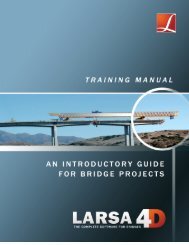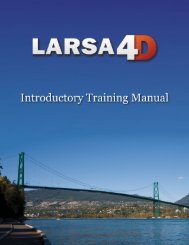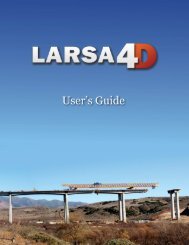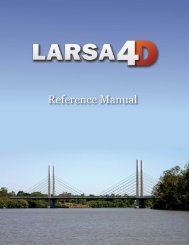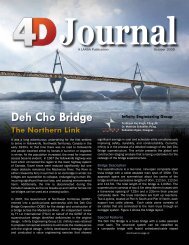You also want an ePaper? Increase the reach of your titles
YUMPU automatically turns print PDFs into web optimized ePapers that Google loves.
Features On Demand<br />
Our team is well known for providing timely and useful<br />
technical support, webinars, and on-site training. Our newest<br />
support system is called “Features On Demand.” This allows<br />
us to provide new features directly to waiting clients without<br />
having to go through our normal software release cycle and<br />
without the user having to uninstall and reinstall an updated<br />
version of LARSA 4D (which can be inconvenient in corporate<br />
offices). New features that we have been able to provide within<br />
hours include automatic generation of bridge path coordinate<br />
systems based on existing model geometry and computing the<br />
length of patch loading in influence line analysis.<br />
As the lean, mean, structure-solving machine, we always are<br />
on the look-out for new ways to deliver on our promise for<br />
unparalleled support services. “LARSA Live” is another new<br />
tool in our arsenal for rapidly providing new custom-build tools<br />
to our clients. LARSA Live allows users to run LARSA 4D off the<br />
Internet without having to install it. This means users can run<br />
an old and new version of LARSA 4D at the same time, and the<br />
new version can be tested without requiring IT’s help to install<br />
the program.<br />
We’re Going Global<br />
The software will soon be available in a select few languages<br />
besides English. Our British clients have told us they can’t<br />
understand our software’s New York drawl.<br />
The Shell Element<br />
It’s a common misconception that Indiana Jones was searching<br />
for the Holy Grail. In fact, he was looking for the Unified Shell<br />
Element, an advanced element formulation that will allow<br />
users to combine separate plate and membrane models into a<br />
single shell element.<br />
Cable Reincarnation<br />
What does reincarnation have to do with nonlinear analysis?<br />
The cable element’s “rebirth” capability is when it goes in and<br />
out of an analysis depending on whether it is under tension.<br />
When the cable goes into compression, it is taken out of the<br />
analysis because the cable has no compressive strength.<br />
This can make nonlinear convergence more difficult, so we<br />
LARSA 4D and Section Composer are being updated for composite<br />
construction.<br />
are adding a new option: cable compressive strength. When<br />
this option is used, cables in compression will retain a small<br />
fraction of their tensile strength.<br />
Composite Sections (Almost!)<br />
In software development it is notoriously difficult to estimate<br />
how long it will take to deliver on a promise. More than three<br />
years ago we began work on composite section construction.<br />
This major update to the LARSA 4D analysis engine would<br />
allow member cross-sections to be built up over time in the<br />
Staged Construction Analysis. A girder might be placed first<br />
with a deck (modeled in the cross-section) cast later on.<br />
Though the parts are combined into a single line element,<br />
they have different time-dependent effects such as creep. This<br />
update also includes nonlinear thermal gradients. We began<br />
previewing this update on a limited basis in 2010 and expect a<br />
public preview later this year.•<br />
After adding a “thick plate” element formulation, we<br />
added drilling degrees of freedom to “membrane element”<br />
formulation. Drilling degrees of freedom provide for more<br />
realistic modeling when the shell is subject to a torque about<br />
its normal axis.<br />
We have also added shell element end offsets, much like<br />
member end offsets, which is useful for creating rigid<br />
connections between a girder and a deck. Twelve end offset<br />
values (x, y, z for each node) can be entered for each plate.<br />
Cable Compressive Strength is a new option for nonlinear analysis types to<br />
make convergence easier.<br />
•LARSA’s 4D <strong>Journal</strong> • May 2010•Page 3



